Geochemical Features of Lacustrine Shales in the Upper Cretaceous Qingshankou Formation of Changling Sag, Songliao Basin, Northeast China
Abstract
1. Introduction
2. Geologic Setting
3. Samples and Experiments Methods
3.1. Samples
3.2. Experimental Methods
4. Results and Discussion
4.1. Mineral Compositions and Lithofacies Classification
4.2. Organic Geochemical Characteristics
4.2.1. Organic Matter Abundance
4.2.2. Types of Organic Matter
4.2.3. Maturity
4.3. Paleoenvironment
4.3.1. Sources of Organic Matter
4.3.2. Redox Environment
5. Conclusions
Author Contributions
Funding
Institutional Review Board Statement
Informed Consent Statement
Data Availability Statement
Acknowledgments
Conflicts of Interest
References
- Newport, L.; Aplin, A.; Gluyas, J. Geochemical and lithological controls on a potential shale reservoir: Carboniferous Holywell Shale, Wales. Mar. Pet. Geol. 2016, 71, 198–210. [Google Scholar] [CrossRef]
- Wang, M.; Guo, Z.; Jiao, C. Exploration progress and geochemical features of lacustrine shale oils in China. J. Pet. Sci. Eng. 2019, 178, 975–986. [Google Scholar] [CrossRef]
- Li, J.; Lu, S.; Zhang, J.; Zhang, P.; Xue, H. Quantitative evaluation models of adsorbed and free shale oil and its microscopic occurrence mechanism. Oil Gas Geol. 2019, 40, 583–592. [Google Scholar]
- Bechtel, A.; Jia, J.; Strobl, S.; Sachsenhofer, R.F. Palaeoenvironmental conditions during deposition of the Upper Cretaceous oil shale sequences in the Songliao Basin (NE China): Implications from geochemical analysis. Org. Geochem. 2012, 46, 76–95. [Google Scholar] [CrossRef]
- Fan, X.; Su, J.Z.; Chang, X.; Huang, Z.W.; Zhou, T.; Guo, Y.T.; Wu, S.Q. Brittleness evaluation of the inter-salt shale oil reservoir in Jianghan Basin in China. Mar. Pet. Geol. 2018, 102, 109–115. [Google Scholar] [CrossRef]
- Liu, B.; Sun, J.; Zhang, Y.; He, J.; Fu, X.; Yang, L.; Xing, J.; Zhao, X. Reservoir space and enrichment model of shale oil in the first member of Cretaceous Qingshankou Formation in the Changling Sag, southern Songliao Basin, NE China. Pet. Explor. Dev. 2021, 48, 17. [Google Scholar] [CrossRef]
- Wang, Z.; Tang, Y.; Wang, Y. Kinetics of shale oil generation from kerogen in saline basin and its exploration significance: An example from the Eocene Qianjiang Formation, Jianghan Basin, China—ScienceDirect. J. Anal. Appl. Pyrolysis 2020, 150, 104885. [Google Scholar] [CrossRef]
- Xu, J.; Liu, Z.; Bechtel, A.; Sachsenhofer, R.; Jia, J.; Meng, Q.; Sun, P. Organic matter accumulation in the Upper Cretaceous Qingshankou and Nenjiang Formations, Songliao Basin (NE China): Implications from high-resolution geochemical analysis. Mar. Pet. Geol. 2019, 102, 187–201. [Google Scholar] [CrossRef]
- Katz, B. Controls on distribution of lacustrine source rocks through time. AAPG 1990, 50, 132–139. [Google Scholar]
- Neumann, V.; Borrego, A.; Cabrera, L.; Dino, R. Organic matter composition and distribution through the Aptian–Albian lacustrine sequences of the Araripe Basin, northeastern Brazil. Int. J. Coal Geol. 2003, 54, 21–40. [Google Scholar] [CrossRef]
- He, T.; Li, W.; Lu, S.; Yang, E.; Jing, T.; Ying, J.; Zhu, P.; Wang, X.; Pan, W.; Zhang, B.; et al. Quantitatively unmixing method for complex mixed oil based on its fractions carbon isotopes: A case from the Tarim Basin, NW China. Pet. Sci. 2022. in press. [CrossRef]
- Wei, H.; Chen, D.; Wang, J.; Yu, H.; Tucker, M. Organic accumulation in the lower Chihsia Formation (Middle Permian) of South China: Constraints from pyrite morphology and multiple geochemical proxies. Palaeogeogr. Palaeoclimatol. Palaeoecol. 2012, 353–355, 73–86. [Google Scholar] [CrossRef]
- Cao, H.; Kaufman, A.; Shan, X.; Cui, H.; Zhang, G. Sulfur isotope constraints on marine transgression in the lacustrine Upper Cretaceous Songliao Basin, northeastern China. Palaeogeogr. Palaeoclimatol. Palaeoecol. 2016, 451, 152–163. [Google Scholar] [CrossRef]
- Ding, X.; Liu, G.; Zha, M. Characteristics and origin of lacustrine source rocks in the Lower Cretaceous, Erlian Basin, northern China. Mar. Pet. Geol. 2015, 66, 939–955. [Google Scholar] [CrossRef]
- Jones, M.; Ibarra, D.; Gao, Y.; Sageman, B.; Selby, D.; Chamberlain, C.; Graham, S. Evaluating Late Cretaceous OAEs and the influence of marine incursions on organic carbon burial in an expansive East Asian paleo-lake. Earth Planet. Sci. Lett. 2018, 484, 41–52. [Google Scholar] [CrossRef]
- Tong, X.; Hu, J.; Xi, D.; Zhu, M.; Song, J.; Peng, P. Depositional environment of the Late Santonian lacustrine source rocks in the Songliao Basin (NE China): Implications from organic geochemical analyses. Org. Geochem. 2018, 124, 215–227. [Google Scholar] [CrossRef]
- Wang, Y.; Deng, S.W.; Fan, J.; Zou, X.P.; Yang, J. Natural gas geology, resource potential and favorable exploration direction in the south of Songliao Basin. Nat. Gas Geosci. 2018, 29, 1455–1464. [Google Scholar]
- Li, Z.; Bao, Z.; Wei, Z.; Wang, H.; Zhao, W.; Dong, W.; Shen, Z.; Wu, F.; Tian, W.; Li, L. Characteristics and Affecting Factors of K 2 qn 1 Member Shale Oil Reservoir in Southern Songliao Basin, China. Energies 2022, 15, 2269. [Google Scholar] [CrossRef]
- Wu, Y.; Lu, Y.; Jiang, S. Pore structure characterization of different lithofacies in marine shale: A case study of the Upper Ordovician Wufeng-Lower Silurian Longmaxi formation in the Sichuan Basin, SW China. J. Nat. Gas Sci. Eng. 2018, 57, 203–215. [Google Scholar] [CrossRef]
- Guo, X.; Qin, Z.; Yang, R. Comparison of pore systems of clay-rich and silica-rich gas shales in the lower Silurian Longmaxi formation from the Jiaoshiba area in the eastern Sichuan Basin, China. Mar. Pet. Geol. 2019, 101, 265–280. [Google Scholar] [CrossRef]
- Xu, S.; Gou, Q.; Hao, F. Shale pore structure characteristics of the high and low productivity wells, Jiaoshiba shale gas field, Sichuan Basin, China: Dominated by lithofacies or preservation condition? Mar. Pet. Geol. 2020, 114, 104211. [Google Scholar] [CrossRef]
- Baban, D. Sedimentary organic matter and source rock potential of the Paleocene Aaliji Formation in Qumar Oil Field, NE Iraq. Arab. J. Geosci. 2014, 7, 4733–4744. [Google Scholar] [CrossRef]
- Tissot, B.; Welte, D. Petroleum Formation and Occurrence; Springer: Berlin/Heidelberg, Germany; New York, NY, USA, 1984. [Google Scholar]
- Peters, K.; Cassa, M. Applied Source Rock Geochemistry: Chapter 5: Part II. Essential Elements; AAPG: Houston, TX, USA, 1994; pp. 93–120. [Google Scholar]
- Wang, M.; Wilkins, R.; Song, G. Geochemical and geological characteristics of the Es3L lacustrine shale in the Bonan sag, Bohai Bay Basin, China. Int. J. Coal Geol. 2015, 138, 16–29. [Google Scholar] [CrossRef]
- He, T.; Li, W.; Lu, S.; Yang, E.; Jing, T.; Ying, J.; Zhu, P.; Wang, X.; Pan, W.; Chen, Z. Distribution and isotopic signature of 2-alkyl-1,3,4-trimethylbenzenes in the Lower Paleozoic source rocks and oils of Tarim Basin: Implications for the oil-source correlation. Pet. Sci. 2022, in press. [Google Scholar] [CrossRef]
- John, M. Generation of gas and oil from coal and other terrestrial organic matter. Org. Geochem. 1991, 17, 673–680. [Google Scholar]
- Karayigit, A.; Oskay, R.; Elik, Y. Mineralogy, petrography, and Rock-Eval pyrolysis of late Oligocene coal seams in the Malkara coal field from the Thrace Basin (NW Turkey). Int. J. Coal Geol. 2021, 244, 103814. [Google Scholar] [CrossRef]
- Pepper, A.; Corvi, P. Simple kinetic models of petroleum formation. Part I: Oil and gas generation from kerogen. Mar. Pet. Geol. 1995, 12, 291–319. [Google Scholar] [CrossRef]
- Yang, S.; Horsfield, B. Critical review of the uncertainty of Tmax in revealing the thermal maturity of organic matter in sedimentary rocks. Int. J. Coal Geol. 2020, 225, 103500. [Google Scholar] [CrossRef]
- Vu, T.; Horsfield, B.; Mahlstedt, N.; Schenk, H.; Kelemen, S.; Walters, C.; Kwiatek, P.; Sykes, R. The structural evolution of organic matter during maturation of coals and its impact on petroleum potential and feedstock for the deep biosphere. Org. Geochem. 2013, 62, 17–27. [Google Scholar] [CrossRef]
- Carvajal-Ortiz, H.; Gentzis, T. Geochemical screening of source rocks and reservoirs: The importance of using the proper analytical program. Int. J. Coal Geol. 2018, 190, 56–69. [Google Scholar] [CrossRef]
- Sanei, H.; Petersen, H.; Schovsbo, N.; Jiang, C.; Goodsite, M. Petrographic and geochemical composition of kerogen in the Furongian (U. Cambrian) Alum Shale, central Sweden: Reflections on the petroleum generation potential. Int. J. Coal Geol. 2014, 132, 158–169. [Google Scholar] [CrossRef]
- Cornford, C.; Gardner, P.; Burgess, C. Geochemical truths in large data sets. I: Geochemical screening data. Org. Geochem. 1998, 29, 530. [Google Scholar] [CrossRef]
- Liu, B.; Mastalerz, M.; Schieber, J. SEM petrography of dispersed organic matter in black shales: A review. Earth-Sci. Rev. 2022, 224, 103874. [Google Scholar] [CrossRef]
- Hackley, P.C.; Cardott, B.J. Application of organic petrography in North American shale petroleum systems: A review. Int. J. Coal Geol. 2016, 163, 8–51. [Google Scholar] [CrossRef]
- Peters, K.E.; Moldowan, J. The Biomarker Guide: Interpreting Molecular Fossils in Petroleum and Ancient Sediments; Prentice Hall: Englewood Cliffs, NJ, USA, 1993. [Google Scholar]
- Peters, K.; Walters, C.; Moldowan, J. The Biomarker Guide: Biomarkers and Isotopes in Petroleum Systems and Earth History; Cambridge University Press: Cambridge, UK, 2004. [Google Scholar]
- Seifert, W.; Moldowan, J. Use of biological markers in petroleum exploration. Methods Geochem. 1986, 24, 261–290. [Google Scholar]
- He, T.; Li, W.; Lu, S.; Pan, W.; Sun, D. Mechanism and geological significance of anomalous negative δ13Ckerogen in the Lower Cambrian, NW Tarim Basin, China. J. Pet. Sci. Eng. 2021, 208, 109384. [Google Scholar] [CrossRef]
- Bray, E.; Evans, E. Distribution of n-paraffins as a clue to recognition of source beds. Geochim. Cosmochim. Acta 1961, 22, 2–15. [Google Scholar] [CrossRef]
- Scalan, E.; Smith, J.E. An improved measure of the odd-even predominance in the normal alkanes of sediment extracts and petroleum. Geochim. Cosmochim. Acta 1970, 34, 611–620. [Google Scholar] [CrossRef]
- Bhattacharya, S.; Dutta, S.; Summons, R. A distinctive biomarker assemblage in an Infracambrian oil and source rock from western India: Molecular signatures of eukaryotic sterols and prokaryotic carotenoids. Precambrian Res. 2016, 290, 101–112. [Google Scholar] [CrossRef]
- Huang, W.; Meinschein, W. Sterols as ecological indicators. Geochim. Cosmochim. Acta 1979, 43, 739–745. [Google Scholar] [CrossRef]
- Hao, F.; Zhou, X.; Zhu, Y.; Yang, Y. Lacustrine source rock deposition in response to co-evolution of environments and organisms controlled by tectonic subsidence and climate, Bohai Bay Basin, China. Org. Geochem. 2012, 42, 323–339. [Google Scholar] [CrossRef]
- He, T.; Lu, S.; Li, W.; Tan, Z.; Zhang, X. Effect of Salinity on Source Rock Formation and Its Control on the Oil Content in Shales in the Hetaoyuan Formation from the Biyang Depression, Nanxiang Basin, Central China. Energy Fuels 2018, 32, 6698–6707. [Google Scholar] [CrossRef]
- Li, W.; Lu, S.; Tan, Z.; He, T. Lacustrine Source Rock Deposition in Response to Co-evolution of Paleoenvironment and Formation Mechanism of Organic-rich Shales in the Biyang De-pression, Nanxiang Basin. Energy Fuels 2017, 31, 13519–13527. [Google Scholar] [CrossRef]
- Celik, Y.; Karayigit, A.; Oskay, R.; Zer, M. A multidisciplinary study and palaeoenvironmental interpretation of middle Miocene Keles lignite (Harmanck Basin, NW Turkey), with emphasis on syngenetic zeolite formation. Int. J. Coal Geol. 2021, 237, 103691. [Google Scholar] [CrossRef]
- Bai, Y.; Liu, Z.; George, S.; Meng, J. A Comparative Study of Different Quality Oil Shales Developed in the Middle Jurassic Shimengou Formation, Yuqia Area, Northern Qaidam Basin, China. Energies 2022, 15, 1231. [Google Scholar] [CrossRef]
- Warwick, P.; Hook, R. Petrography, geochemistry, and depositional setting of the San Pedro and Santo Tomas coal zones: Anomalous algae-rich coals in the middle part of the Claiborne Group (Eocene) of Webb County, Texas. Int. J. Coal Geol. 1995, 28, 303–342. [Google Scholar] [CrossRef]
- Moldowan, J.; Sundararaman, P.; Schoell, M. Sensitivity of biomarker properties to depositional environment and/or source input in the Lower Toarcian of SW-Germany. Org. Geochem. 1986, 10, 915–926. [Google Scholar] [CrossRef]
- Damsté, J.; Kenig, F.; Koopmans, M. Evidence for gammacerane as an indicator of water column stratification. Geochim. Cosmochim. Acta 1995, 59, 1895. [Google Scholar] [CrossRef]
- Didyk, B.; Simoneit, B.; Brassell, S.; Eglinton, G. Organic geochemical indicators of palaeoenvironmental conditions of sedimentation. Nature 1978, 272, 216–222. [Google Scholar] [CrossRef]
- Mello, M.; Telnaes, N.; Gaglianone, P.; Chicarelli, M.; Brassell, S.; Maxwell, J. Organic geochemical characterisation of depositional palaeoenvironments of source rocks and oils in Brazilian marginal basins. Org. Geochem. 1988, 13, 31–45. [Google Scholar] [CrossRef]
- Chen, D.; Pang, X.; Li, L.; Jiang, F.; Han, W. Organic geochemical characteristics and shale oil potential of the middle Eocene early-mature shale in the Nanpu Sag, Bohai Bay Basin, Eastern China. Mar. Pet. Geol. 2021, 4, 105248. [Google Scholar] [CrossRef]
- Ten, H.; De Leeuw, J.; Rullk, T.; Damsté, J. Restricted utility of the pristane/phytane ratio as a palaeoenvironmental indicator. Nature 1987, 330, 641–643. [Google Scholar]
- Zhou, W.; Zheng, Y.; Meyers, P.; Jull, A.; Xie, S. Postglacial climate-change record in biomarker lipid compositions of the Hani peat sequence, Northeastern China. Earth Planet. Sci. Lett. 2010, 294, 37–46. [Google Scholar] [CrossRef]
- Shanmugam, G. Significance of coniferous rain forests and related organic matter in generating commercial quantities of oil, Gippsland Basin, Australia. AAPG Bull. 1985, 69, 1241–1254. [Google Scholar] [CrossRef]
- Si, W.; Hou, D.; Wu, P.; Zhao, Z.; Cao, L. Geochemical characteristics of lower cretaceous lacustrine organic matter in the southern sag of the Wuliyasitai depression, Erlian Basin, China. Mar. Pet. Geol. 2020, 118, 104404. [Google Scholar] [CrossRef]
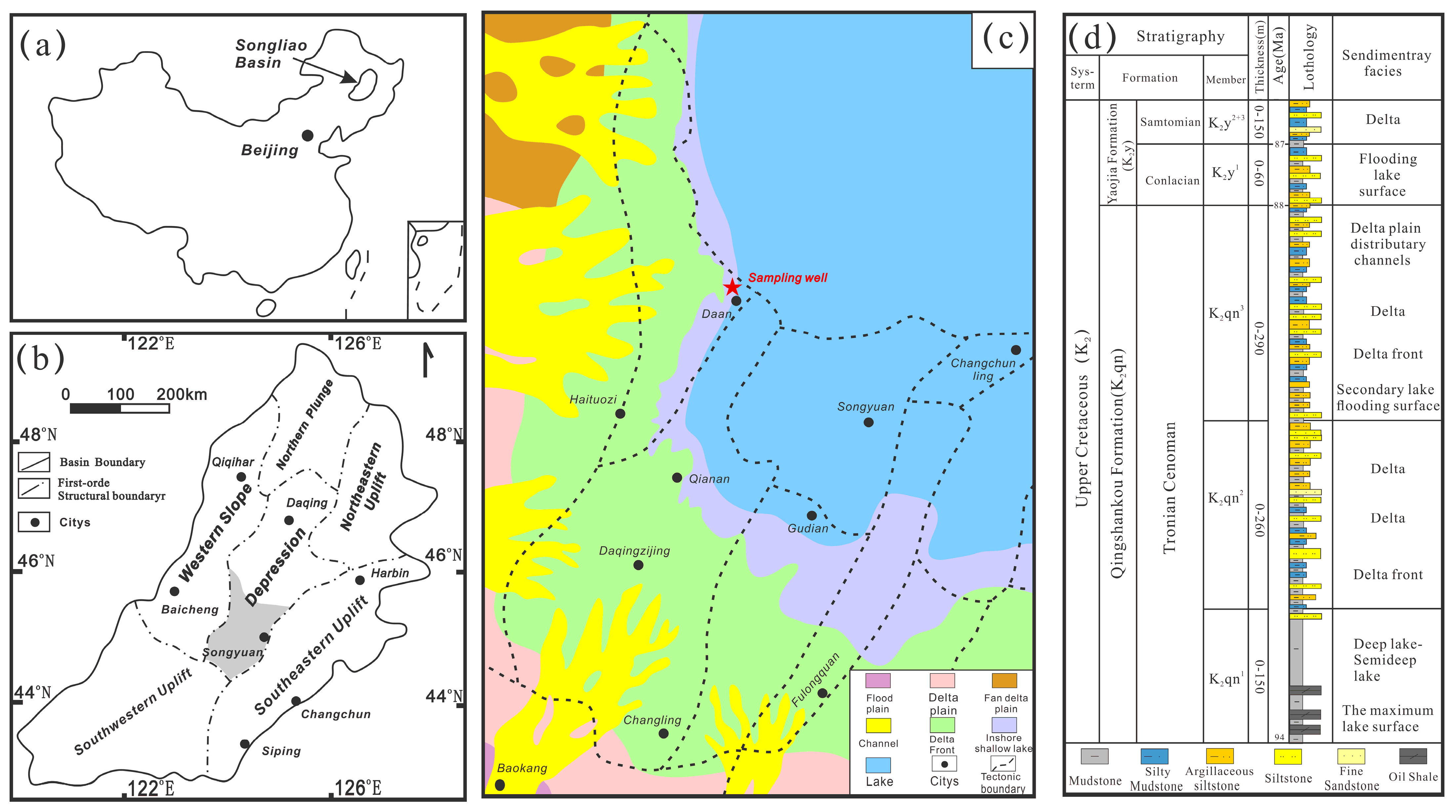
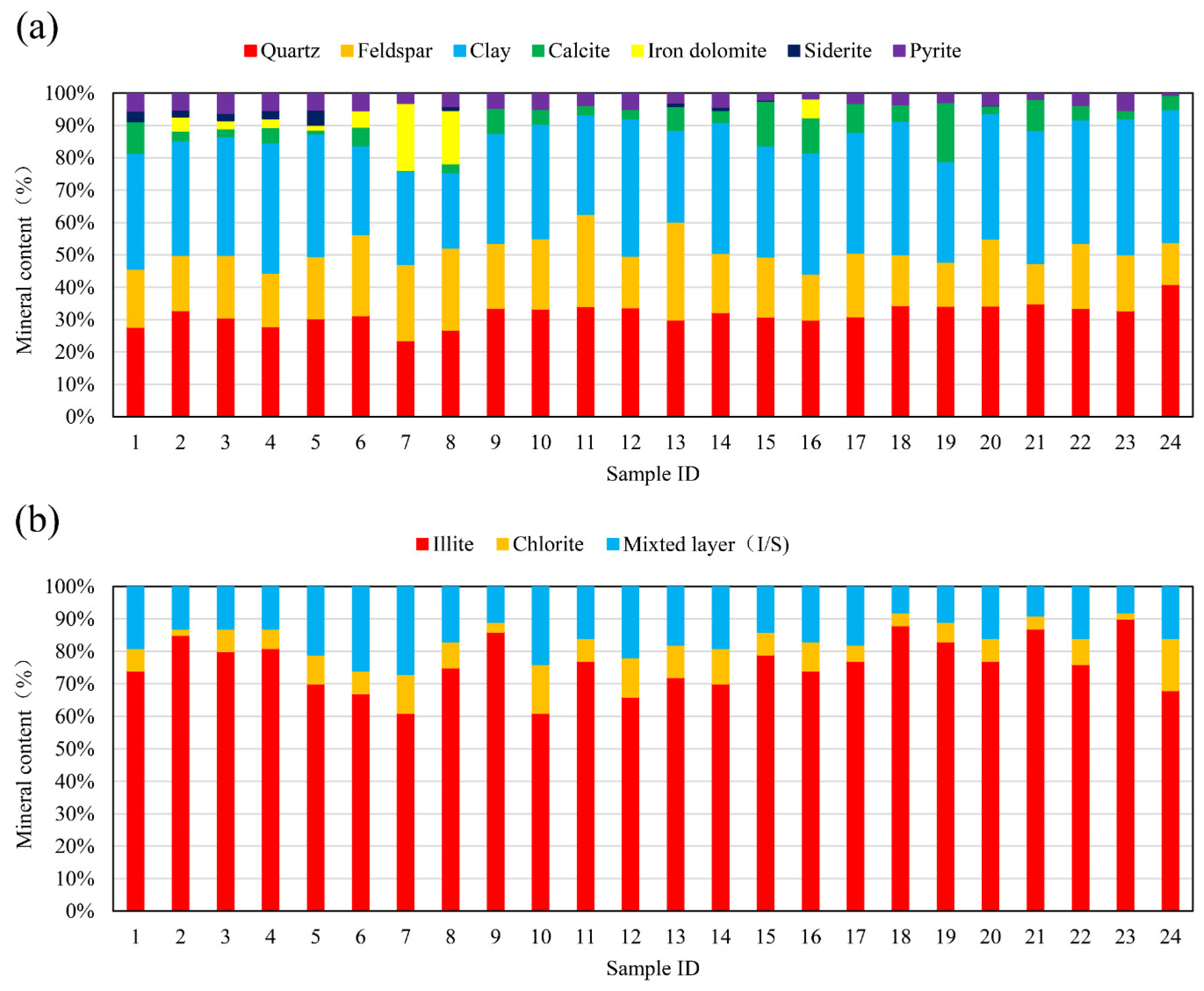
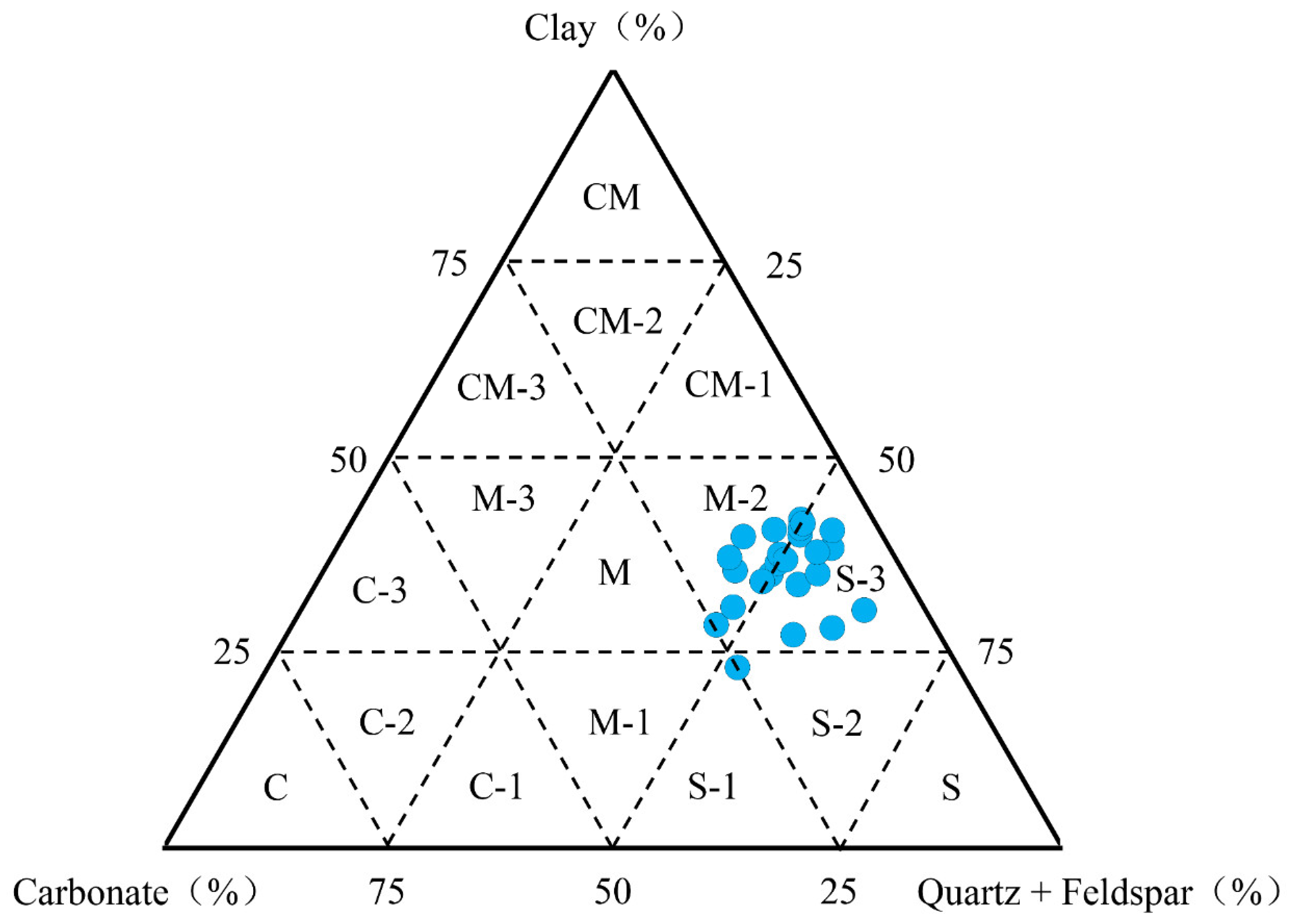
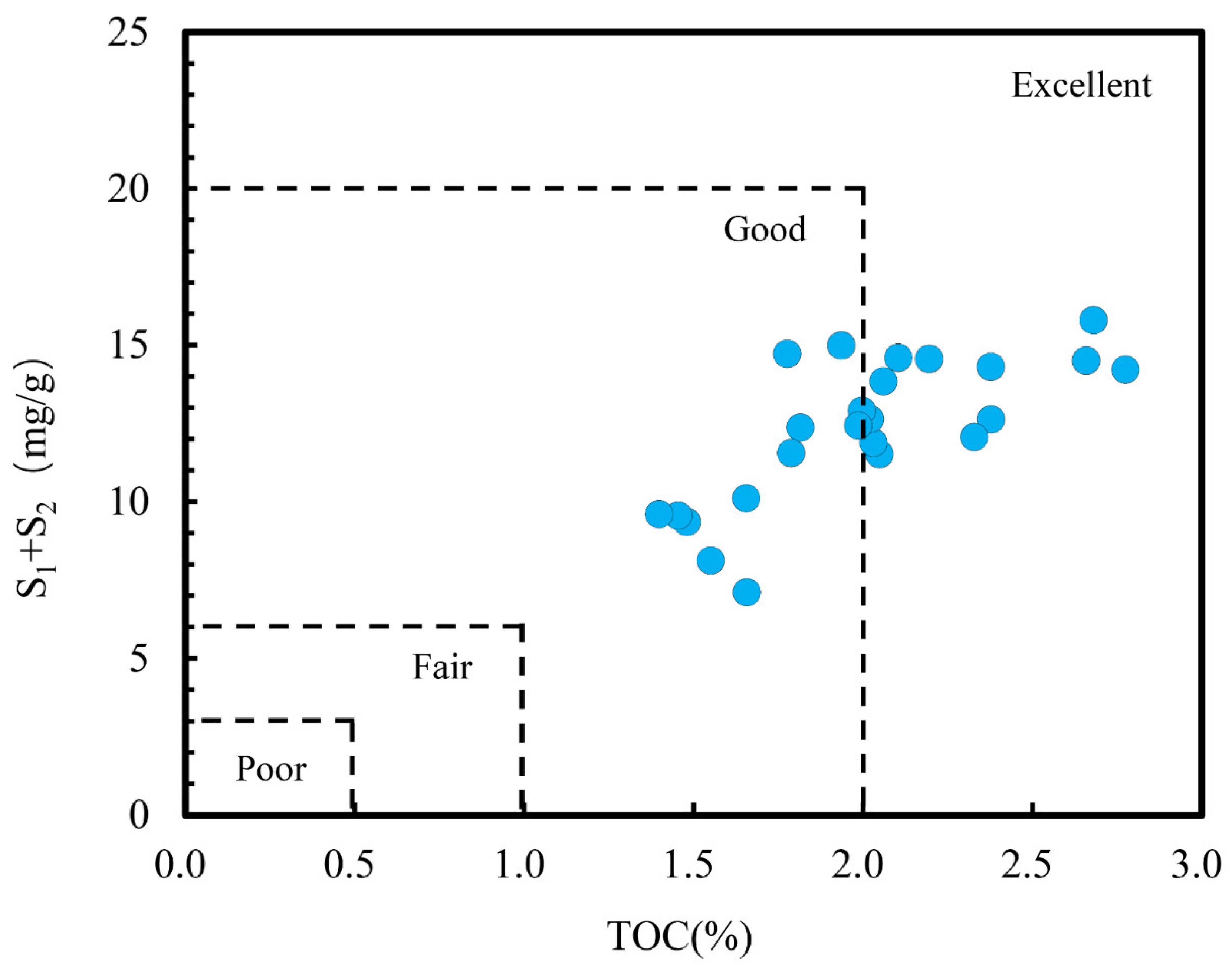

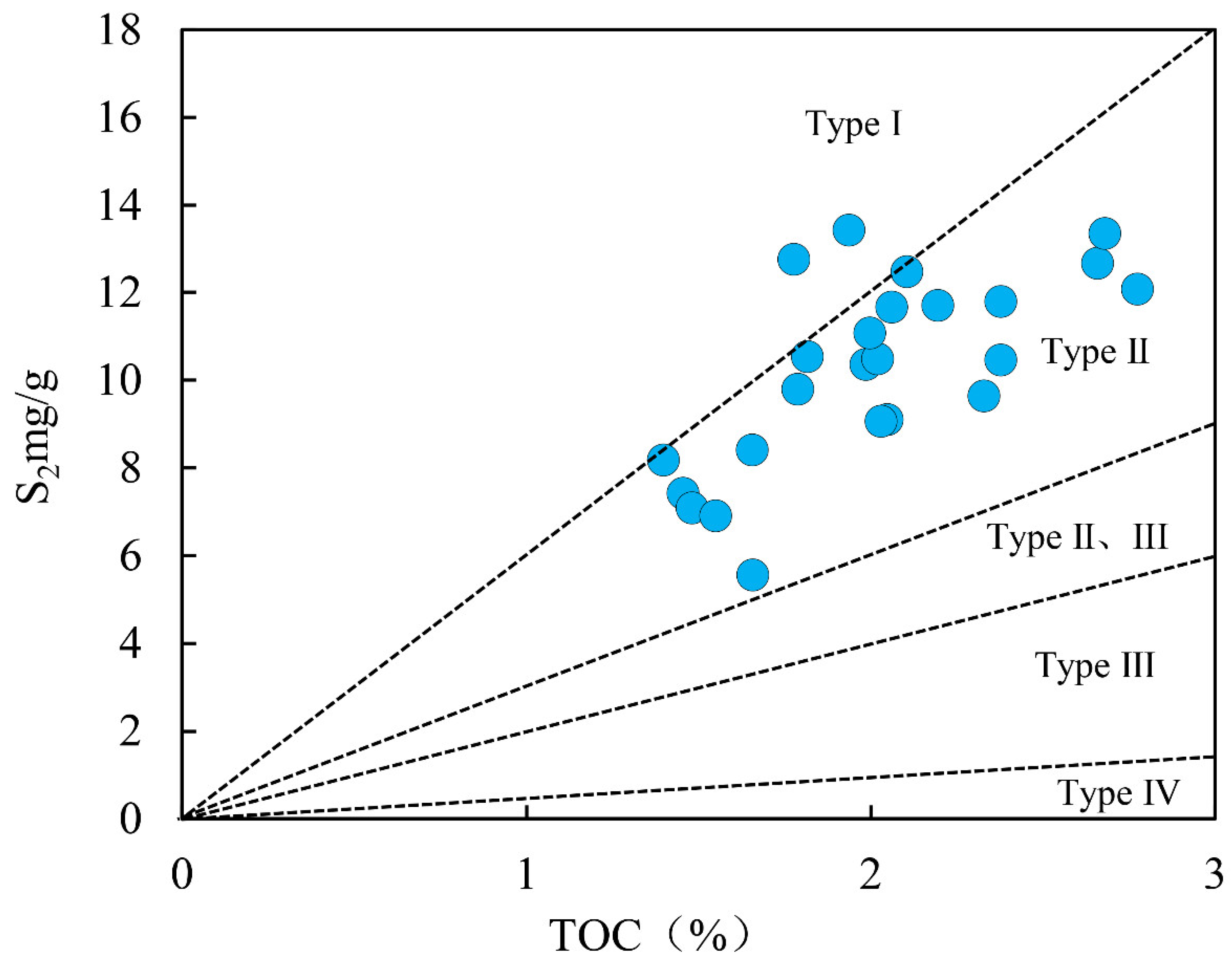
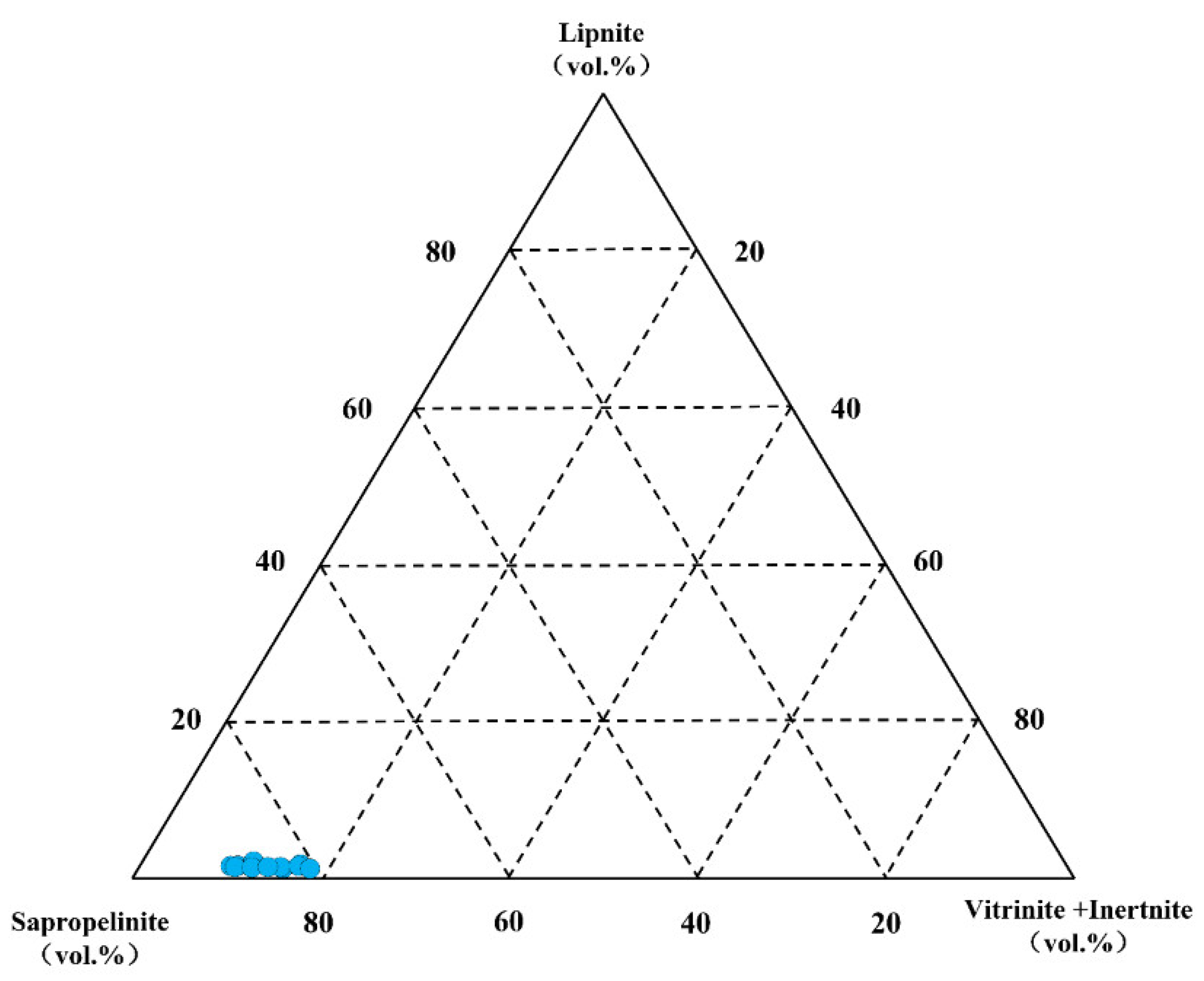
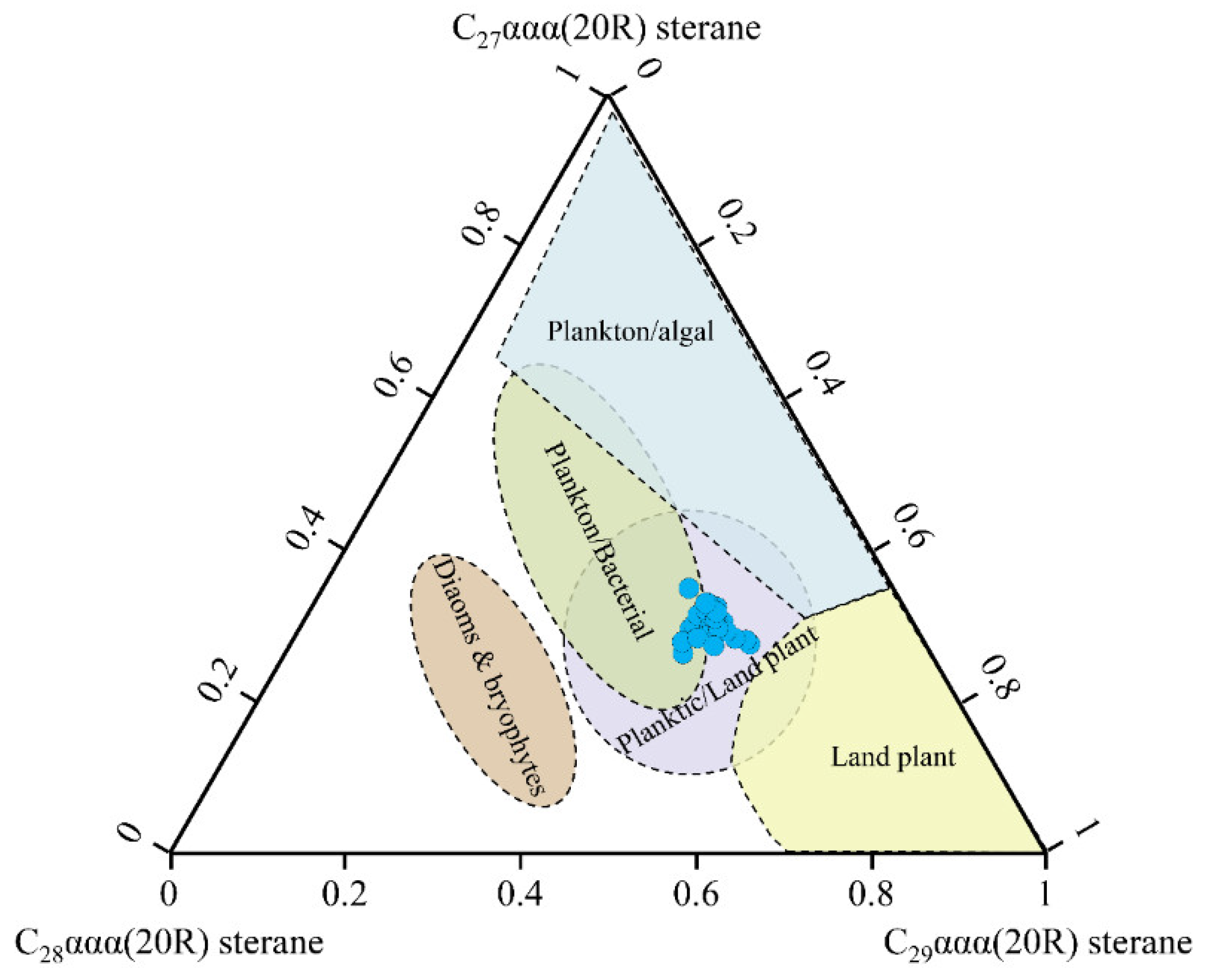
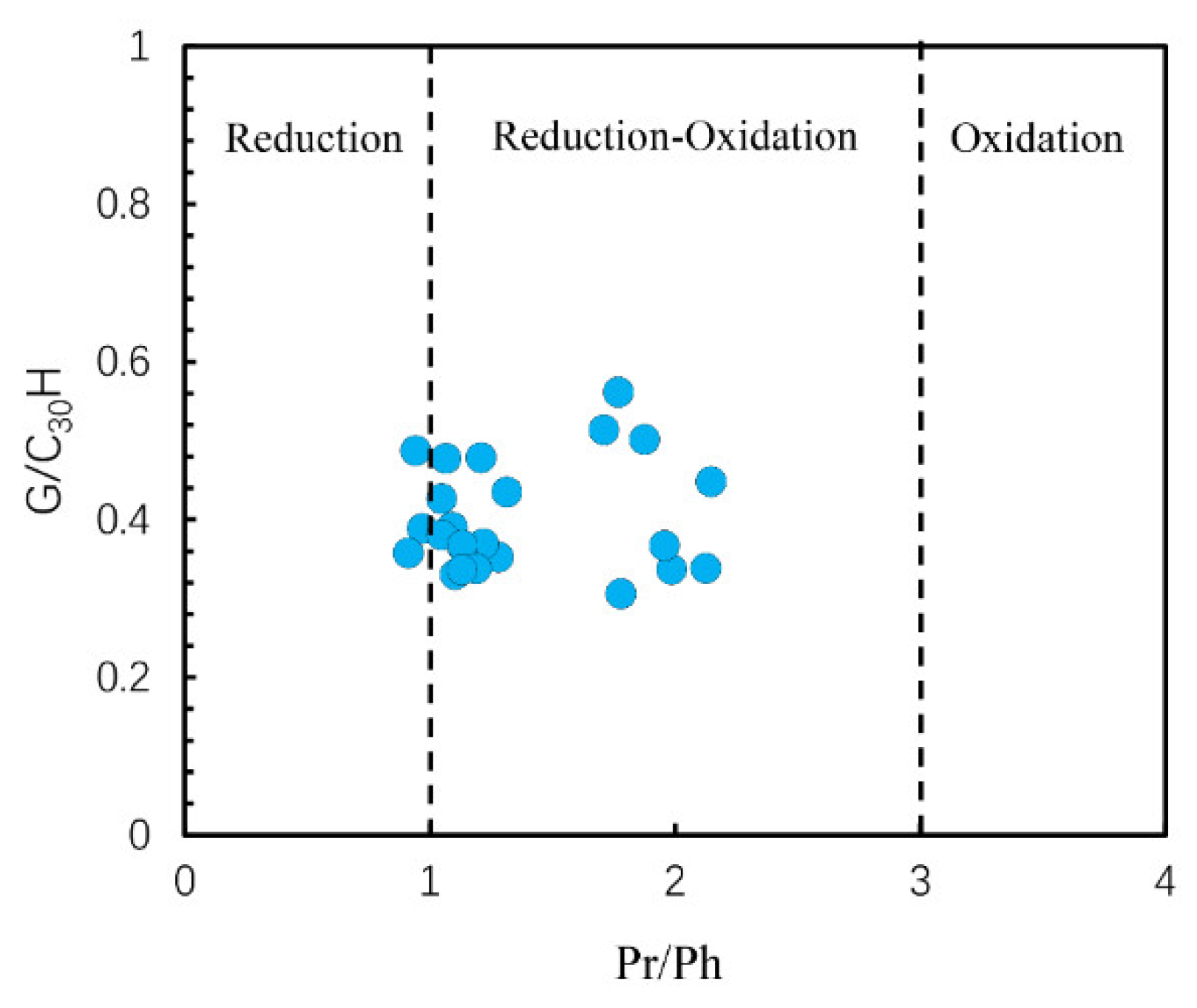
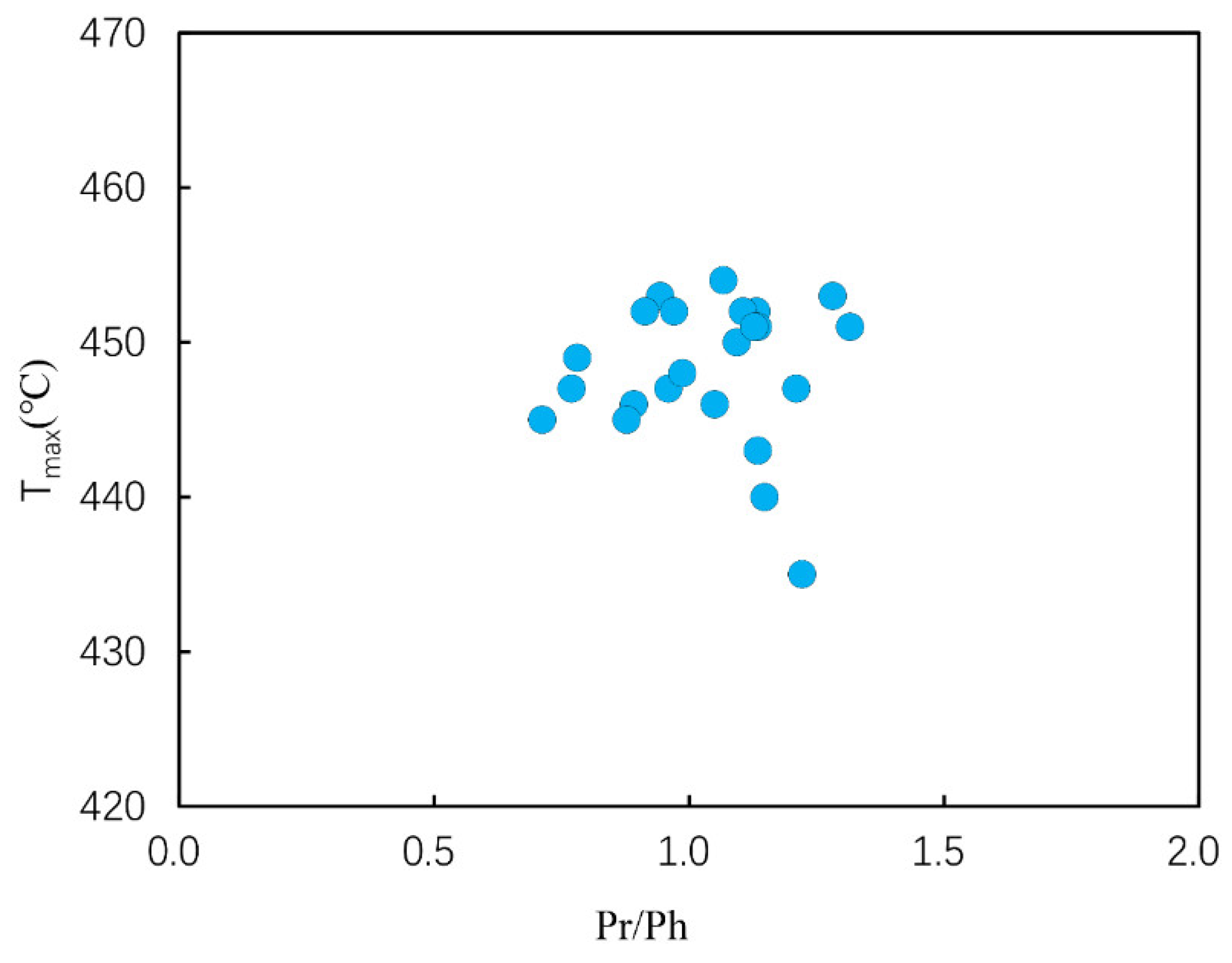
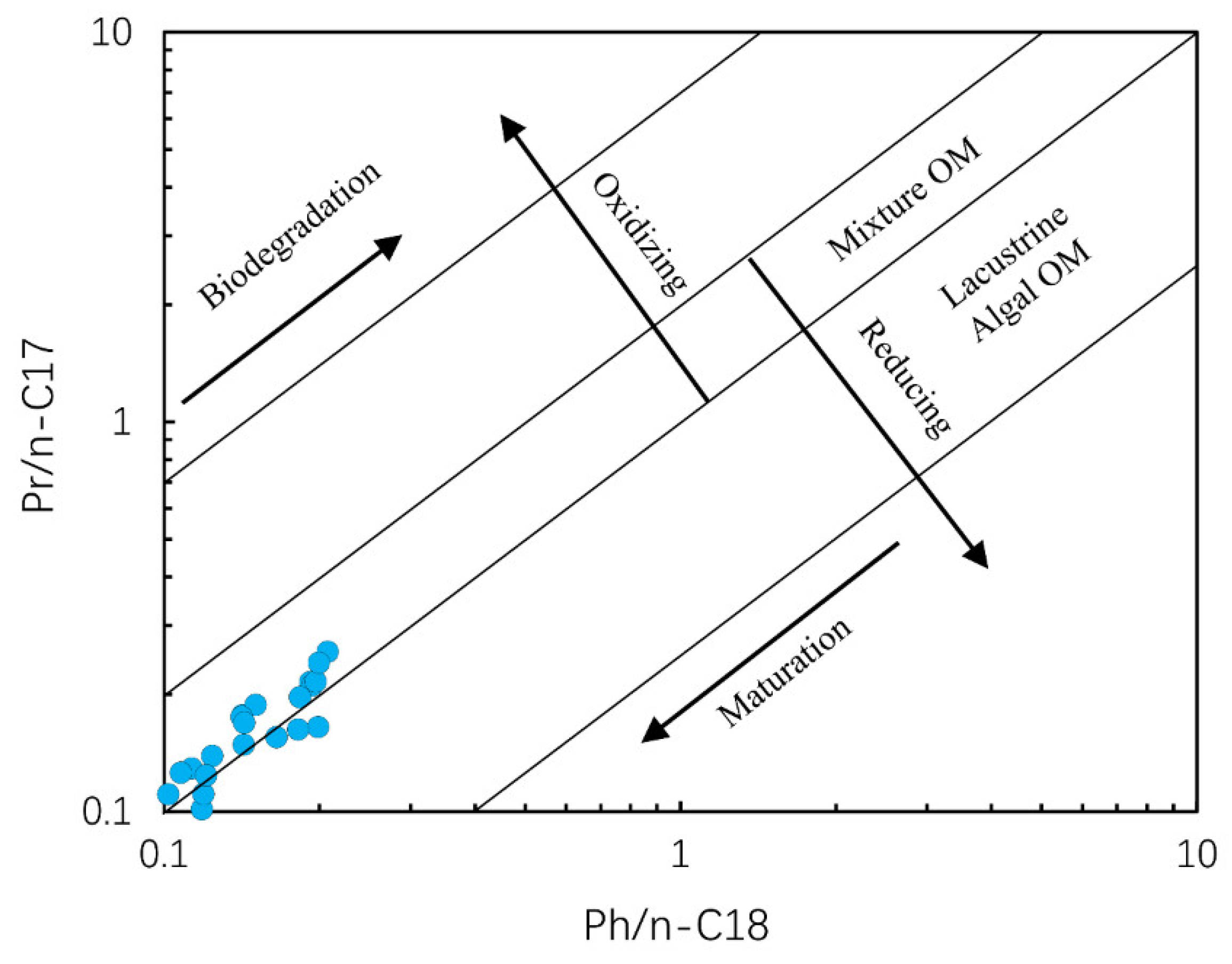
| Sample ID | Depth | Quartz | Feldspar | Calcite | Iron Dolomite | Siderite | Pyrite | Clay | Illite | Chlorite | Mixted Layer (I/S) | Lithology |
|---|---|---|---|---|---|---|---|---|---|---|---|---|
| 1 | 1971.2 | 27.7 | 18 | 9.7 | 3.3 | 5.5 | 35.8 | 74 | 7 | 19 | M-2 | |
| 2 | 1976.9 | 32.9 | 17 | 3.1 | 4.4 | 2.1 | 5.2 | 35.3 | 85 | 2 | 13 | M-2 |
| 3 | 1979.6 | 30.6 | 19.3 | 2.4 | 2.5 | 2.3 | 6.2 | 36.7 | 80 | 7 | 13 | M-2 |
| 4 | 1982.2 | 27.9 | 16.5 | 4.7 | 2.7 | 2.6 | 5.3 | 40.2 | 81 | 6 | 13 | M-2 |
| 5 | 1984.3 | 30.4 | 19.2 | 1.2 | 1.5 | 4.7 | 5.2 | 37.9 | 70 | 9 | 21 | M-2 |
| 6 | 2001.8 | 31.3 | 25 | 5.7 | 5.1 | 5.4 | 27.5 | 67 | 7 | 26 | S-3 | |
| 7 | 2003.7 | 23.6 | 23.5 | 0.3 | 20.7 | 3.1 | 28.8 | 61 | 12 | 27 | M-2 | |
| 8 | 2009.7 | 26.9 | 25.3 | 2.7 | 16.5 | 1.2 | 4.1 | 23.3 | 75 | 8 | 17 | S-2 |
| 9 | 2011.9 | 33.5 | 20.1 | 7.7 | 4.7 | 34 | 86 | 3 | 11 | S-3 | ||
| 10 | 2014.6 | 33.4 | 21.7 | 4.5 | 5 | 35.4 | 61 | 15 | 24 | S-3 | ||
| 11 | 2016.2 | 34.1 | 28.5 | 2.9 | 3.8 | 30.7 | 77 | 7 | 16 | S-3 | ||
| 12 | 2017.8 | 33.7 | 16 | 2.9 | 5 | 42.4 | 66 | 12 | 22 | M-2 | ||
| 13 | 2025.5 | 30 | 30.2 | 7.3 | 1.1 | 3 | 28.4 | 72 | 10 | 18 | S-3 | |
| 14 | 2030.5 | 32.3 | 18.3 | 3.7 | 1 | 4.3 | 40.4 | 70 | 11 | 19 | S-3 | |
| 15 | 2033.3 | 30.9 | 18.5 | 13.7 | 0.4 | 2.1 | 34.4 | 79 | 7 | 14 | M-2 | |
| 16 | 2035.6 | 30 | 14.2 | 10.9 | 5.8 | 1.7 | 37.5 | 74 | 9 | 17 | M-2 | |
| 17 | 2038.0 | 30.9 | 19.7 | 9 | 3.1 | 37.2 | 77 | 5 | 18 | S-3 | ||
| 18 | 2042.8 | 34.5 | 15.7 | 5 | 3.6 | 41.3 | 88 | 4 | 8 | S-3 | ||
| 19 | 2044.3 | 34.2 | 13.6 | 18.2 | 2.9 | 31.1 | 83 | 6 | 11 | M-2 | ||
| 20 | 2046.5 | 34.3 | 20.7 | 2.4 | 0.2 | 3.7 | 38.7 | 77 | 7 | 16 | S-3 | |
| 21 | 2048.2 | 35 | 12.4 | 9.6 | 1.9 | 41.1 | 87 | 4 | 9 | M-2 | ||
| 22 | 2051.3 | 33.5 | 20.1 | 4.5 | 3.7 | 38.2 | 76 | 8 | 16 | S-3 | ||
| 23 | 2055.0 | 32.8 | 17.4 | 2.6 | 5.3 | 41.9 | 90 | 2 | 8 | S-3 | ||
| 24 | 2062.6 | 41 | 12.9 | 4.5 | 0.6 | 41 | 68 | 16 | 16 | S-3 |
| Sample ID | Depth | TOC | S₁ | S₂ | S₁ + S₂ | S1/(S₁ + S₂) | HI | OI | Tmax | Ro | CPI | C27st% | C28st% | C29st% | (G/C30H) | (Pr/Ph) | Ph/nC18 | Pr/nC17 |
|---|---|---|---|---|---|---|---|---|---|---|---|---|---|---|---|---|---|---|
| 1 | 1971.2 | 1.94 | 1.57 | 13.42 | 14.99 | 0.10 | 693 | 0.64 | 446 | 1.01 | 1.14 | 27.78 | 19.88 | 52.34 | 0.34 | 0.89 | 0.10 | 0.10 |
| 2 | 1976.9 | 1.40 | 1.43 | 8.17 | 9.60 | 0.15 | 584 | 0.57 | 447 | 1.03 | 1.10 | 28.54 | 21.20 | 50.26 | 0.37 | 0.96 | 0.10 | 0.10 |
| 3 | 1979.6 | 1.78 | 1.96 | 12.76 | 14.72 | 0.13 | 718 | 0.69 | 448 | 1.05 | 1.09 | 30.71 | 21.48 | 47.81 | 0.34 | 0.99 | 0.10 | 0.11 |
| 4 | 1982.2 | 1.82 | 1.82 | 10.54 | 12.36 | 0.15 | 580 | 0.57 | 447 | 1.08 | 1.09 | 26.52 | 28.13 | 45.34 | 0.56 | 0.77 | 0.10 | 0.01 |
| 5 | 1984.3 | 1.79 | 1.76 | 9.79 | 11.55 | 0.15 | 547 | 0.54 | 445 | 1.07 | 1.09 | 29.72 | 23.97 | 46.32 | 0.50 | 0.88 | 0.12 | 0.10 |
| 6 | 2001.8 | 1.46 | 2.13 | 7.42 | 9.55 | 0.22 | 510 | 0.54 | 440 | 1.04 | 1.11 | 30.31 | 25.01 | 44.68 | 0.45 | 1.15 | 0.14 | 0.18 |
| 7 | 2003.7 | 2.66 | 1.83 | 12.67 | 14.50 | 0.13 | 476 | 0.45 | 453 | 1.07 | 1.11 | 31.61 | 23.90 | 44.49 | 0.49 | 0.94 | 0.14 | 0.15 |
| 8 | 2009.7 | 1.48 | 2.27 | 7.08 | 9.35 | 0.24 | 478 | 0.53 | 445 | 1.01 | 1.10 | 29.95 | 23.42 | 46.62 | 0.51 | 0.71 | 0.20 | 0.16 |
| 9 | 2011.9 | 1.66 | 1.55 | 5.56 | 7.11 | 0.22 | 335 | 0.36 | 451 | 1.08 | 1.12 | 29.94 | 23.32 | 46.74 | 0.43 | 1.32 | 0.21 | 0.26 |
| 10 | 2014.6 | 2.06 | 2.18 | 11.66 | 13.84 | 0.16 | 566 | 0.56 | 447 | 1.07 | 1.12 | 32.52 | 22.26 | 45.22 | 0.48 | 1.21 | 0.15 | 0.19 |
| 11 | 2016.2 | 2.78 | 2.14 | 12.08 | 14.22 | 0.15 | 435 | 0.43 | 454 | 1.08 | 1.11 | 29.69 | 23.26 | 47.05 | 0.48 | 1.07 | 0.19 | 0.21 |
| 12 | 2017.8 | 1.99 | 2.07 | 10.36 | 12.43 | 0.17 | 522 | 0.52 | 443 | 1.08 | 1.12 | 29.87 | 22.85 | 47.28 | 0.37 | 1.13 | 0.19 | 0.21 |
| 13 | 2025.5 | 2.05 | 2.41 | 9.10 | 11.51 | 0.21 | 444 | 0.47 | 446 | 1.07 | 1.17 | 28.58 | 25.43 | 45.98 | 0.38 | 1.05 | 0.20 | 0.22 |
| 14 | 2030.5 | 2.02 | 2.14 | 10.49 | 12.63 | 0.17 | 519 | 0.52 | 449 | 1.10 | 1.12 | 32.10 | 21.74 | 46.16 | 0.31 | 0.78 | 0.18 | 0.16 |
| 15 | 2033.3 | 2.33 | 2.42 | 9.64 | 12.06 | 0.20 | 414 | 0.43 | 450 | 1.07 | 1.10 | 29.48 | 21.71 | 48.80 | 0.39 | 1.09 | 0.18 | 0.20 |
| 16 | 2035.6 | 2.03 | 2.82 | 9.06 | 11.88 | 0.24 | 446 | 0.49 | 435 | 1.09 | 1.11 | 30.67 | 22.16 | 47.17 | 0.37 | 1.22 | 0.20 | 0.24 |
| 17 | 2038.0 | 2.38 | 2.16 | 10.46 | 12.62 | 0.17 | 440 | 0.44 | 453 | 1.05 | 1.10 | 29.89 | 22.44 | 47.67 | 0.35 | 1.28 | 0.14 | 0.17 |
| 18 | 2042.8 | 2.20 | 2.85 | 11.71 | 14.56 | 0.20 | 533 | 0.55 | 452 | 1.07 | 1.08 | 35.17 | 23.14 | 41.69 | 0.39 | 0.97 | 0.17 | 0.16 |
| 19 | 2044.3 | 1.66 | 1.70 | 8.41 | 10.11 | 0.17 | 508 | 0.51 | 452 | 1.11 | 1.09 | 31.23 | 22.13 | 46.65 | 0.34 | 1.13 | 0.11 | 0.13 |
| 20 | 2046.5 | 2.00 | 1.83 | 11.07 | 12.90 | 0.14 | 554 | 0.54 | 451 | 1.12 | 1.10 | 27.54 | 24.11 | 48.35 | 0.37 | 1.14 | 0.14 | 0.17 |
| 21 | 2048.2 | 2.11 | 2.11 | 12.48 | 14.59 | 0.14 | 593 | 0.57 | 452 | 1.05 | 1.14 | 32.71 | 21.87 | 45.42 | 0.36 | 0.91 | 0.12 | 0.11 |
| 22 | 2051.3 | 2.38 | 2.52 | 11.79 | 14.31 | 0.18 | 496 | 0.50 | 452 | 1.10 | 1.20 | 33.23 | 21.99 | 44.79 | 0.33 | 1.11 | 0.12 | 0.14 |
| 23 | 2055.0 | 1.55 | 1.22 | 6.90 | 8.12 | 0.15 | 445 | 0.43 | 451 | 1.07 | 1.17 | 32.01 | 21.56 | 46.43 | 0.34 | 1.13 | 0.11 | 0.13 |
| 24 | 2062.6 | 2.68 | 2.44 | 13.35 | 15.79 | 0.15 | 498 | 0.49 | 459 | 1.06 | 1.17 | 33.20 | 22.24 | 44.56 | 0.43 | 1.05 | 0.12 | 0.12 |
| Sample ID | Depth (m) | Sapropelinite (%) | Liptinite (%) | Vitrinite (%) | Inertinite (%) | TI | Type |
|---|---|---|---|---|---|---|---|
| 1 | 1971.18 | 81.3 | 1.3 | 9.3 | 8.0 | 67.0 | II1 |
| 2 | 1976.86 | 81.4 | 1.4 | 10.0 | 7.1 | 67.5 | II1 |
| 3 | 1979.55 | 87.1 | 1.1 | 6.5 | 5.4 | 77.4 | II1 |
| 4 | 1982.21 | 84.8 | 1.0 | 7.1 | 7.1 | 73.0 | II1 |
| 5 | 1984.25 | 86.5 | 1.0 | 8.3 | 4.2 | 76.6 | II1 |
| 6 | 2001.83 | 87.9 | 1.1 | 5.5 | 5.5 | 78.8 | II1 |
| 7 | 2003.73 | 83.5 | 1.0 | 12.4 | 3.1 | 71.6 | II1 |
| 8 | 2009.67 | 86.4 | 1.7 | 6.8 | 5.1 | 77.1 | II1 |
| 9 | 2011.9 | 87.5 | 1.3 | 6.3 | 5.0 | 78.4 | II1 |
| 10 | 2014.61 | 86.2 | 1.7 | 6.9 | 5.2 | 76.7 | II1 |
| 11 | 2016.19 | 87.2 | 1.1 | 6.4 | 5.3 | 77.7 | II1 |
| 12 | 2017.79 | 88.8 | 1.3 | 5.0 | 5.0 | 80.6 | I |
| 15 | 2033.26 | 88.9 | 1.1 | 6.7 | 3.3 | 81.1 | I |
| 16 | 2035.55 | 86.7 | 1.1 | 6.7 | 5.6 | 76.7 | II1 |
| 17 | 2038.03 | 88.2 | 1.2 | 5.9 | 4.7 | 79.7 | II1 |
| 18 | 2042.78 | 81.6 | 1.3 | 9.2 | 7.9 | 67.4 | II1 |
| 20 | 2046.54 | 80.6 | 1.0 | 7.1 | 11.2 | 64.5 | II1 |
| 22 | 2051.29 | 83.7 | 1.1 | 7.6 | 7.6 | 70.9 | II1 |
| 24 | 2062.55 | 85.1 | 1.1 | 8.5 | 5.3 | 73.9 | II1 |
Publisher’s Note: MDPI stays neutral with regard to jurisdictional claims in published maps and institutional affiliations. |
© 2022 by the authors. Licensee MDPI, Basel, Switzerland. This article is an open access article distributed under the terms and conditions of the Creative Commons Attribution (CC BY) license (https://creativecommons.org/licenses/by/4.0/).
Share and Cite
Li, Z.; Bao, Z.; Wei, Z.; Li, L.; Wang, H. Geochemical Features of Lacustrine Shales in the Upper Cretaceous Qingshankou Formation of Changling Sag, Songliao Basin, Northeast China. Energies 2022, 15, 6983. https://doi.org/10.3390/en15196983
Li Z, Bao Z, Wei Z, Li L, Wang H. Geochemical Features of Lacustrine Shales in the Upper Cretaceous Qingshankou Formation of Changling Sag, Songliao Basin, Northeast China. Energies. 2022; 15(19):6983. https://doi.org/10.3390/en15196983
Chicago/Turabian StyleLi, Zhongcheng, Zhidong Bao, Zhaosheng Wei, Lei Li, and Hailong Wang. 2022. "Geochemical Features of Lacustrine Shales in the Upper Cretaceous Qingshankou Formation of Changling Sag, Songliao Basin, Northeast China" Energies 15, no. 19: 6983. https://doi.org/10.3390/en15196983
APA StyleLi, Z., Bao, Z., Wei, Z., Li, L., & Wang, H. (2022). Geochemical Features of Lacustrine Shales in the Upper Cretaceous Qingshankou Formation of Changling Sag, Songliao Basin, Northeast China. Energies, 15(19), 6983. https://doi.org/10.3390/en15196983





